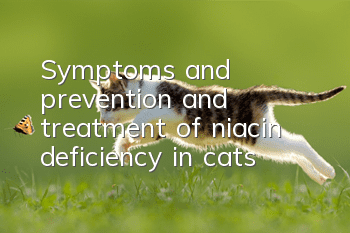Symptoms and prevention and treatment of niacin deficiency in cats

Etiological analysis of niacin deficiency in cats
Niacin, also called vitamin PP or vitamin B3, is a water-soluble vitamin. Cats lacking this vitamin are prone to stomatitis and dermatitis. So what are the main causes of niacin deficiency in cats? Cause
Niacin is found in many animal and plant feeds. It is abundant in cereals, yeast, wheat bran, liver, kidney and other foods, but it is very small in corn. It also contains acetylpyrimidine that has anti-niacin effect. So cats are fed corn for a long time. Niacin deficiency is prone to occur. 0.25 mg per kilogram of body weight for adult cats. Niacin deficiency may also occur when there are very few animal products in the cat's food. Niacin is mainly present in the body as nicotinamide. Nicotinamide is a component of coenzyme I and coenzyme II. These two enzymes are coenzymes of many dehydrogenases in the body. They play an important role in normal tissue cell respiration and metabolism of carbohydrates, proteins, and fats, and are important in maintaining skin and Digestive function is of great significance. Dogs can convert tryptophan into niacin in their bodies, but cats do not have this ability. Therefore, niacin deficiency can occur even when tryptophan is included in cat food.
What are the symptoms of niacin deficiency in cats
Niacin is a water-soluble vitamin that is an essential vitamin needed for the growth of cats. This vitamin is widely found in the food of animals and plants. The most serious case of niacin deficiency in cats can lead to mental problems such as epileptic seizures, confusion, and even death.
Symptoms
When cats are deficient in niacin, their skin will be rough, with erythema and exudate, and dry black scabs will form. The most important symptoms are black disease, loss of appetite, thirst, bad oral odor, flushing of mucous membranes, and red to dark blue pigmentation on the tongue mucosa. The mucosa of the lips and cheeks forms dense pustules, and even ulcers, bleeding and necrosis occur. Thick and foul-smelling saliva constantly flows from the mouth. Sick cats have elevated body temperatures and staggering gait; some have cramps or diarrhea.
Diagnosis, prevention and treatment of niacin deficiency in cats
The occurrence of niacin deficiency in cats is mostly secondary. Clinically, it is mainly a nutritional and metabolic disease characterized by black tongue and pellagra. The early symptoms of affected cats are not obvious. So how to correctly diagnose the disease? What should you do if your cat is deficient?
1. Diagnosis
1. Symptom diagnosis
A preliminary diagnosis can be made based on typical dermatitis, diarrhea, oral ulcers and neurological symptoms.
2. Laboratory diagnosis
Blood test found niacinDiagnosis can be made when the content decreases and the total number of red blood cells decreases, and the above characteristics are found.
2. Prevention
1. Principles of prevention
Strengthen feeding and management, feed foods rich in nicotinic acid (meat, fish, eggs), and often give yeast tablets.
2. Treatment measures
[Prescription 1] Niacin tablets 0.6 mg per kilogram of body weight, taken orally, 3 times a day, for one week.
[Prescription 2] Niacin injection 0.25 mg per kilogram of body weight, intramuscular injection, once a day, for one week.
- Do kittens meow when they are born?
- Why does my cat have a runny nose?
- What to do if a kitten eats cat litter
- What are the side effects of lactulose for cats with constipation?
- What are the cat training techniques? A must-read for every poop scooper!
- What should I do if my cat is too greedy?
- Communication with cats is more important than training, so that you can get along with cats better!
- What should I do if my cat eats cat litter?
- Why should cats eat cat grass? What is the scientific basis for giving cats grass?
- How much does a Turkish Van cat weigh?



